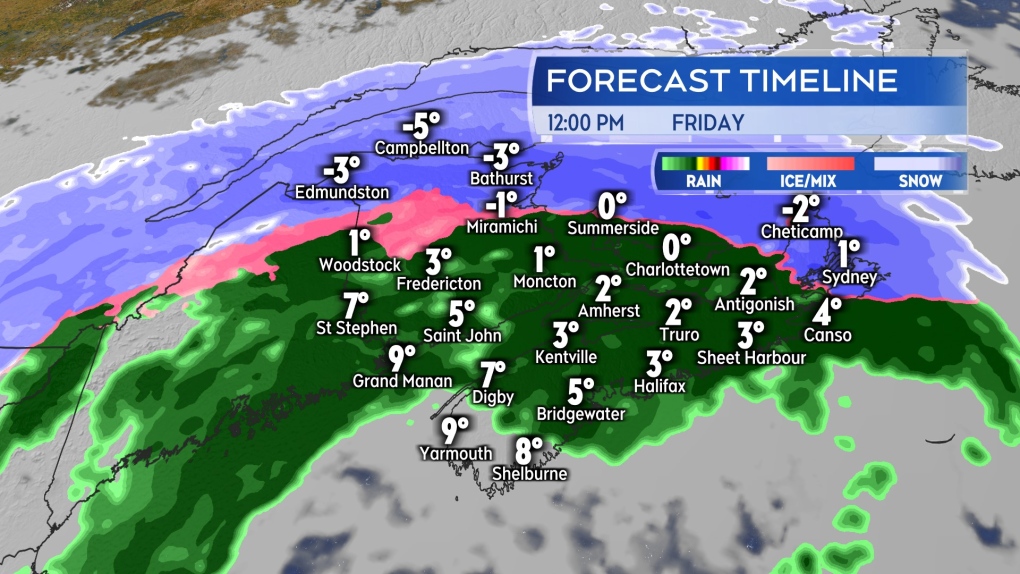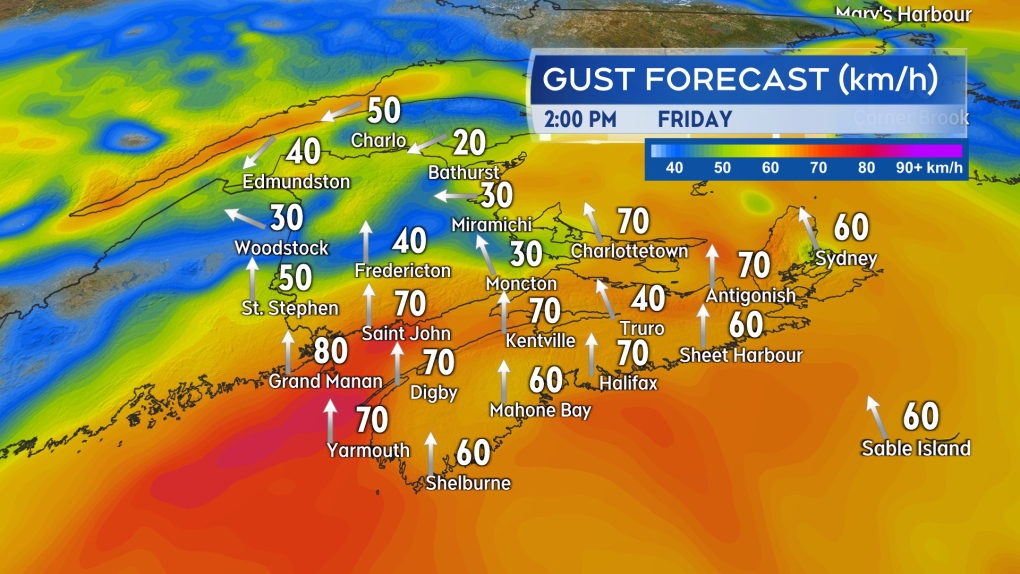Winter storm timing and impacts for the Maritimes
A developing winter storm moving towards Quebec and Maine will bring a mix of heavy snow, freezing rain, rain and gusty southerly winds to the Maritimes Friday into Saturday.
TIMING
Weather conditions deteriorate quickly in the Maritimes Friday morning into afternoon. Snow becomes heavy and widespread in New Brunswick Friday morning.
Snow turning to rain will spread across Nova Scotia and towards Prince Edward Island.
By Friday afternoon, southern New Brunswick, P.E.I., and Nova Scotia will all be in rain.
Central areas of New Brunswick can expect a mix of ice pellets, freezing rain, and rain.
Northern areas of New Brunswick is forecast to see heavy snow and ice pellets.
Rain is expected for most of Friday night with a continuing mix of snow, ice pellets, and freezing rain for the northernmost communities of New Brunswick.
More rain is forecast for P.E.I. and Nova Scotia Saturday, with a patchy, icy mix of precipitation for New Brunswick.
 Snow and ice pellets turn to freezing rain and rain for much of the Maritimes Friday afternoon.
Snow and ice pellets turn to freezing rain and rain for much of the Maritimes Friday afternoon.
SNOW
The highest snowfall totals are expected in northern New Brunswick. The area from Edmundston to Bathurst could pick up 30 to 45 cm. Just south of that area, from Grand Falls to Miramichi, 20 to 30 cm is a reasonable expectation.
Woodstock, Fredericton, and eastward into western P.E.I. could pick up 10 to 20 cm of snow and ice pellets before a turn to freezing rain and rain.
Moncton, N.B., Charlottetown, and northern Cumberland County in Nova Scotia, as well as the Cape Breton Highlands, will see up to 10 cm before a turn to rain. The remainder of the Maritimes should generally see five cm or less of snow before a turn to rain.
Most of New Brunswick is under a winter storm warning. A snowfall warning is in effect for Prince and Queens counties on P.E.I.
 The most snow is expected in northern New Brunswick with progressively more rain expected south and east.
The most snow is expected in northern New Brunswick with progressively more rain expected south and east.
RAIN
Through Friday, the most rain is expected near the Bay of Fundy coastline of New Brunswick where rainfall warnings have been issued. Thirty to 50 mm of rain in that area could contribute to hydroplaning conditions on roads and localized flooding at low points in terrain.
Rain amounts of 10 to 25 mm are expected for P.E.I. and Nova Scotia on Friday. However, for both of those provinces, additional rain on Saturday could bring storm totals into the 30 to 50+ mm range.
Regardless, it's important to keep in mind that the winter ground is frozen and saturated in many areas, which will increase water runoff and associated issues.
It's recommended homeowners make sure property drainage is free and clear of snow and ice.
WIND
Widespread southerly wind gusts of 40 to 80 km/h are expected by Friday afternoon in the region. The strongest gusts are most likely on exposed areas of the coast and higher terrain.
Northern Inverness County in Cape Breton is under a wind warning for gusts that could reach as high as 130 km/h as a result of the topography of the Cape Breton Highlands.
The wind in northern New Brunswick will be lighter but also out of an east/northeast direction. That keeps that part of the Maritimes colder Friday, hence more snow and ice pellet accumulation.
The Confederation Bridge has an advisory out that traffic restrictions may be necessary Friday. Marine Atlantic is advising that the North Sydney – Port aux Basque sailing Friday into Saturday could be impacted.
 A gusty southerly wind will boost up temperatures for most of the Maritimes Friday. A colder east/northeast wind will be present in northern New Brunswick.
A gusty southerly wind will boost up temperatures for most of the Maritimes Friday. A colder east/northeast wind will be present in northern New Brunswick.
NOTES OF CAUTION
Driving conditions on roads for northern and central New Brunswick are likely to be terrible for much of Friday.
Residents should consider postponing non-essential travel if they can. Where the snow does add up to higher totals, it is going to have some weight to it. This is particularly true if ice pellets, freezing rain, and rain mix in.
Maritimers should take their time clearing and take breaks as needed to avoid physical strain.
The weighty snow also increases the risk of drooping or falling tree branches, which would add a risk of power outages should they contact lines.
CTVNews.ca Top Stories

BREAKING Poilievre writes to GG calling for House recall, confidence vote after Singh declares he's ready to bring Liberals down
Conservative Leader Pierre Poilievre has written to Gov. Gen. Mary Simon, imploring her to 'use your authority to inform the prime minister that he must' recall the House of Commons so a non-confidence vote can be held. This move comes in light of NDP Leader Jagmeet Singh publishing a letter stating his caucus 'will vote to bring this government down' sometime in 2025.
'I understand there's going to be a short runway,' new minister says after Trudeau shuffles cabinet
Prime Minister Justin Trudeau added eight Liberal MPs to his front bench and reassigned four ministers in a cabinet shuffle in Ottawa on Friday, but as soon as they were sworn-in, they faced questions about the political future of their government, and their leader.
Judge sentences Quebecer convicted of triple murder who shows 'no remorse'
A Quebecer convicted in a triple murder on Montreal's South Shore has been sentenced to life in prison without chance of parole for 20 years in the second-degree death of Synthia Bussieres.
BREAKING Fake nurse Brigitte Cleroux sentenced to 7 years in prison
A woman who illegally treated nearly 1,000 patients in British Columbia while impersonating a nurse has been sentenced to seven years in prison.
Poilievre to Trump: 'Canada will never be the 51st state'
Conservative leader Pierre Poilievre is responding to U.S. president-elect Donald Trump’s ongoing suggestions that Canada become the 51st state, saying it will 'never happen.'
Toronto officials warn of possible measles exposure at Pearson airport
Toronto Public Health (TPH) is advising of another possible measles exposure at Canada’s largest airport.
Party City closing in U.S., Canadian stores remain 'open for business'
The impending closure of all Party City locations in the United States will not extend into Canada.
BREAKING At least one dead and 50 injured after a car drove into a German Christmas market, official says
A car plowed into a busy outdoor Christmas market in the eastern German city of Magdeburg on Friday, leaving at least one person dead and injuring at least 50 others in what authorities suspect was an attack.
Guelph man facing assault charge after police say he spat in roommate's face during disagreement over cat
A fight between roommates has led to an assault charge for a Guelph man.

































